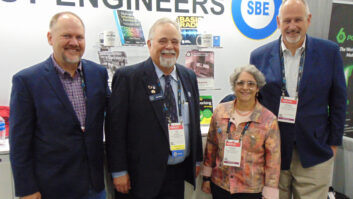
IBiquity executives Jim Spencer, Jeff Jury and Bob Struble at the CES Show. Struble said he anticipates big gains for HD Radio in 2013 across consumer electronics categories.
Credit: Photo by Leslie Stimson IBiquity Digital believes HD Radio has momentum in its consumer electronics business, with accelerating growth in the key segments of aftermarket car radios, premier home audio and portable navigation devices. This builds on expansion in new cars that the company reported in 2012.
President/CEO Bob Struble anticipates big gains for HD Radio in 2013 across CE product categories. The company predicts approximately 60 aftermarket car and home products.
Aftermarket car brands Alpine, JVC, Kenwood, Pioneer and Sony are expanding their HD Radio product lines. Home audio brands Denon, Marantz, McIntosh, Onkyo, Integra and Yamaha are refreshing lines with new models. Most of these will launch with “advanced” HD Radio features like Artist Experience, in which audio is synched with visual elements.
IBiquity anticipates 15 car models will be available with HD Digital Traffic this year. An expanded line of Garmin portable navigation devices supporting HD Digital Traffic will also launch this year.
Beyond audio
Struble said HD Radio is being used for more than audio, and he expects that trend to continue. He pointed to traffic devices that use the platform to deliver data to the car.
For example, Mitsubishi announced that its compact crossover, the 2014 Outlander, will be its first vehicle to have real-time traffic information delivered via HD Radio signals to its dash navigation system. That car is due out in summer.
Now 29 automotive brands offer or have announced plans to offer HD Radio audio, traffic or data features. Many OEMs, including Toyota, Lexus and Mitsubishi, plan to use the digital broadcasts to receive traffic and data information as well.
VW, Chevrolet, Buick, GMC and BMW are the first to offer Artist Experience. Additional automakers, including Lexus and Toyota, have radios in development and plan to offer the feature in coming months, according to iBiquity. AE was available in 12 car models in 2012; that number is expected to rise to 27 this year.
Toyota, Lexus and Mitsubishi were the first automakers to announce the integration of HD Radio to receive both audio and digital traffic services.
Two service providers, Clear Channel and Nokia, have built nationwide networks to broadcast real-time traffic and data information using the HD Radio system. Nokia has partnered with radio station companies that comprise the Broadcaster Traffic Consortium, while Clear Channel uses its own radio stations to support its Total Traffic Network.
Five 2013 vehicles in iBiquity’s CES Show booth featured factory-installed HD Radio receivers with advanced capabilities, including a Chevrolet Traverse, Ford Fusion, Toyota Yaris, Ram Pick Up and Hyundai Santa Fe. Struble singled out the Traverse as notable, a high-volume-selling vehicle from one of the so-called “Big Three” automakers that features Artist Experience.
The big screen
Looking ahead, Struble noted discussion that the federal government might mandate rear-view backup cameras in vehicles for safety reasons. “If they mandate that, you can expect to see a screen in every single car” — and that would have implications at the station level.
“The fact is, if you’re an analog station, broadcasting and being displayed on a screen like that, it’s largely going to be a blank screen. In most instances it will just be your frequency displayed,” said Struble, “whereas we know what the digital display will look like.”
Drivers of Chevys, Fords, BMWs or Volkswagens now can see their stations displayed using HD Radio. With advanced data features, Struble says, those receiver displays show album covers and visuals for multicast channels as well as for other HD Radio features.“That screen gets filled up” with digital radio, he said. “We think it’s a competitive necessity for broadcasters to have a 21st century look” for their display.
“If someone is listening to SiriusXM, or Pandora, iHeartRadio or to their iPod in the car, they’re going to be seeing that stuff; so radio needs to kind of catch up.” Struble believes the industry is beginning to realize this as radio people themselves buy cars with big infotainment screens.
Active Alerts
IBiquity also demonstrated consumer radio products supporting Active Alerts.
This technology allows radio stations to broadcast notifications from the Emergency Alert System through the HD Radio digital broadcast system.
The notifications will generate pop-up text messages and trigger wake-up/snooze capability on compatible receivers during weather emergencies or other local events. Products such as the commercially available JVC KW-NT810HDT carry the feature. IBiquity also demonstrated the feature on an Insignia Narrator; it has previously showed a prototype.
An HD Radio receiver that supports Active Alert will be able to receive an EAS Common Alerting Protocol message from a station that is using Active Alert-enabled HD Radio transmission equipment. If the receiver is off but still powered, it scans the band looking for an HD Radio station that provides the Active Alert service. Once found, the unit rests on that frequency; when the station sends an alert, the unit receives it immediately. The radio “wakes up” and delivers the alert.












